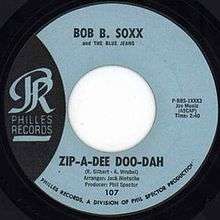Zip-a-Dee-Doo-Dah
"Zip-a-Dee-Doo-Dah" is a song composed by Allie Wrubel with lyrics by Ray Gilbert for the Disney 1946 live action and animated movie Song of the South, sung by James Baskett.[1] For "Zip-a-Dee-Doo-Dah", the film won the Academy Award for Best Original Song[1] and was the second in a long line of Disney songs to win this award, after "When You Wish upon a Star" from Pinocchio (1940).[1] In 2004 it finished at number 47 in AFI's 100 Years...100 Songs, a survey of top tunes in American cinema.
| "Zip-a-Dee-Doo-Dah" | |
|---|---|
| Song by James Baskett | |
| Recorded | 1946 |
| Genre | Jazz |
| Songwriter(s) | Composer: Allie Wrubel Lyricist: Ray Gilbert |
Disney historian Jim Korkis said the word "Zip-a-Dee-Doo-Dah" was reportedly invented by Walt Disney himself, who had a fondness for these types of nonsense words from "Bibbidi-Bobbidi-Boo" to "Supercalifragilisticexpialidocious." [2] The song is likely influenced by the chorus of the pre-Civil War folk song "Zip Coon", a "Turkey in the Straw" variation: "Zip a duden duden duden zip a duden day".[3]
Notable versions
- Johnny Mercer & The Pied Pipers had a no. 8 hit with their rendition of the song in 1947.[4] As a result, Mercer had to correct listeners who mistakenly assumed that he wrote it.[5]
- The Modernaires with Paula Kelly - this reached the No. 11 spot in the Billboard charts in 1946. [6]
- Sammy Kaye & His Orchestra - this also reached the No. 11 spot in the Billboard charts in 1946. [7]
- The Dave Clark Five recorded a version, released in 1964 on the albums The Dave Clark Five Return! and A Session with the Dave Clark Five.
Bob B. Soxx & the Blue Jeans version
| "Zip-a-Dee Doo-Dah" | ||||
|---|---|---|---|---|
 | ||||
| Single by Bob B. Soxx and the Blue Jeans | ||||
| from the album Zip-a-Dee-Doo-Dah | ||||
| B-side | "Flip and Nitty" | |||
| Released | 1962 | |||
| Studio | Gold Star Studios, Los Angeles | |||
| Genre | Pop | |||
| Length | 2:40 | |||
| Label | Philles | |||
| Songwriter(s) | Allie Wrubel, Ray Gilbert | |||
| Producer(s) | Phil Spector | |||
| Bob B. Soxx and the Blue Jeans singles chronology | ||||
| ||||
Bob B. Soxx & the Blue Jeans, a Phil Spector-produced American rhythm and blues trio from Los Angeles, recorded "Zip-a-Dee Doo-Dah" using the Wrecking Crew[8] in late 1962. According to the Beatles' George Harrison: "When Phil Spector was making 'Zip-A-Dee Doo-Dah', the engineer who's set up the track overloaded the microphone on the guitar player and it became very distorted. Phil Spector said, 'Leave it like that, it's great.' Some years later everyone started to try to copy that sound and so they invented the fuzz box."[9] The song also marked the first time his Wall of Sound production formula was fully executed.[10]
In 1963, Bob B. Soxx & the Blue Jeans took their version of the song to number 8 on the Billboard Hot 100 chart and number 7 on the Hot R&B Singles chart.[11] Their song also peaked at number 45 in the UK Singles Chart the same year.[1] The song was included on the only album the group ever recorded, Zip-a-Dee-Doo-Dah, issued on the Philles Records label.
Track listings
- "Zip-a-Dee Doo-Dah" – 2:40
- "Flip and Nitty" - 2:20
Personnel
This version was sung by the following people:[12][13]
- Bobby Sheen – lead vocals
- Darlene Love – background vocals
- Fanita James – background vocals
In popular culture
For many years the song was part of an opening theme medley for the Wonderful World of Disney television program and it has often been used in other TV and video productions by the studio, including being sung as an audition piece by a series of children in the Disney film Life with Mikey. It is one of many popular songs that features a bluebird ("Mr. Bluebird's on my shoulder"), epitomized by the "bluebird of happiness", as a symbol of cheer.
The song is also the Departure melody of platform 1 of Maihama Station in Urayasu, Chiba, Japan.
This song is used as the main song in Splash Mountain, a log flume ride based on Song of the South at Disneyland in Anaheim, California, and Walt Disney World in Lake Buena Vista, Florida.
References
- Brown, David (2006). British Hit Singles & Albums (19th ed.). London: Guinness World Records Limited. p. 134. ISBN 1-904994-10-5.
- https://www.mouseplanet.com/10181/The_Song_of_the_South_Frequently_Asked_Questions
- Emerson, Ken (1997). Doo-dah!: Stephen Foster and the Rise of American Popular Culture. New York: Simon & Schuster. p. 60. ISBN 978-0684810102.
- Johnny Mercer chart entries
- Gilliland, John (1994). Pop Chronicles the 40s: The Lively Story of Pop Music in the 40s (audiobook). ISBN 978-1-55935-147-8. OCLC 31611854. Tape 3, side A.
- Whitburn, Joel (1986). Joel Whitburn's Pop Memories 1890-1954. Menomonee Falls, Wisconsin: Record Research Inc. p. 318. ISBN 0-89820-083-0.
- Whitburn, Joel (1986). Joel Whitburn's Pop Memories 1890-1954. Menomonee Falls, Wisconsin: Record Research Inc. p. 250. ISBN 0-89820-083-0.
- Hartman, Kent (2012). The Wrecking Crew: The Inside Story of Rock and Roll's Best-Kept Secret. Thomas Dunne. ISBN 031261974X.
- Runtagh, Jordan (April 13, 2015). "9 Beatles Songs That Clearly Influenced Heavy Metal". VH1.
- Buskin, Richard (April 2007). "CLASSIC TRACKS: The Ronettes 'Be My Baby'". Sound on Sound. Sound on Sound. Retrieved August 19, 2014.
- Whitburn, Joel (2004). Top R&B/Hip-Hop Singles: 1942-2004. Record Research. p. 68.
- Clemente, John (2000). Girl Groups—Fabulous Females That Rocked The World. Iola, Wisc. Krause Publications. p. 27. ISBN 0-87341-816-6.
- Betrock, Alan (1982). Girl Groups The Story of a Sound (1st ed.). New York: Delilah Books. pgs. 120-122. ISBN 0-933328-25-7